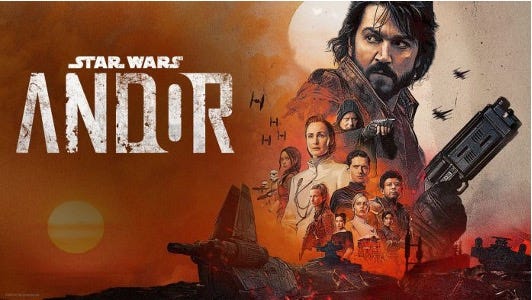In a recent Substack I gave props to Margaret Atwood and Disney+ for their prescient treatment of the impending autocralypse. [Pronounced au-TOC-cra-lypse] That’s my portmanteau for autocratic apocalypse. I’m hoping it catches on before Trump makes the end of democracy a reality.
I gave some of those kudos to the Star Wars prequel Andor, directed by Tony Gilroy. Andor is gorgeous, well-acted, and brilliant—its eye clearly on the Trump presidency and the rise of authoritarianism and rebellion. The narrative is a masterclass in resistance, offering a timely model of what we now need to do. The two-season series follows rebel hero Cassian Andor's reluctant ascent to heroism, delivered through tight scripting and strong performances—light-years ahead of the stilted dialogue and acting that often mars George Lucas’s directorial efforts. Gilroy’s Andor models for us what we need to do now in the time of Trump.
But if Andor is cogent and Atwood is prescient, the laurels for both cogency to the moment and prescient divination go to George Lucas, whose Revenge of the Sith takes both cakes. Revenge of the Sith, the last of the Star Wars movies that Lucas directed (and co-written by Andor’s Gilroy), is a cogent examination of how autocracy seizes the reins of power.
The final film in the Star Wars prequel trilogy, and released in 2005 (28 years after the first Star Wars film), it long precedes Trump’s challenges to Obama’s birth certificate which put him on the political map. While the dialogue and acting are wanting (as they often are in Lucas’s hands), surely Revenge of the Sith deserves the Cassandra Award, for a prophecy that no one believed could happen, but which now nears fulfillment as Palpatine-like Trump goes full-on autocrat.
To the story: Chancellor Palpatine (Ian McDiarmid) is a mask. He is really Darth Sidious whose secret apprenticeship to Darth Plagueis enabled him to remain in a position of power within the Republic while also secretly advancing the Sith agenda. The Sith Order is an ancient religious organization and a plague on (get it?) the Star Warsorderly universe. The Siths pledge allegiance to the Force’s dark side. They can be understood as the Jungian Shadow of the Jedis, who shun the lure of the dark side. Palpatine’s true name Darth Sidious suggests Palpatine is insidiously playing the long game, destroying the Jedi via gradual corruption of the Republic. (No, Lucas’s names are not subtle). Darth Sidious almost succeeds.
Wanting better to understand Andor, I returned to Revenge of the Sith, which precedes it in narrative chronology. The timeline is complicated:
Star Wars: Episode III — Revenge of the Sith (2005)
Andor (2022–2025)
Rogue One (2016)
Star Wars: Episode IV — A New Hope (1977)1
Though made earlier, Rogue One details the Rebellion’s (and an older Andor’s) successful mission to steal the Death Star plans, a crucial event that leads immediately to the death of the entire Rogue One team, and eventually to the events of Episode IV: A New Hope, the first Star Wars movie. There, Luke Skywalker—using the plans located in Andor and secured in Rogue One—destroys the Death Star.
Yes, it’s complicated. My kids could probably explain it better than me. How Lucas over decades fits these long narrative arc puzzle pieces together is astonishing. Legend has it that he had the whole narrative worked out in his head as a film student at USC.
Complicated it is, but want the Star Wars Saga in a nutshell? It can be found in the climax to Episode IV: A New Hope when Luke Skywalker manages to destroy the Death Star. “Use the Force, Luke,” Obe-Wan Kenobi counsels the young Jedi. “Use your feelings.” Turning off his computer, Luke embraces the Force and strikes a blow against empire.
Big picture, “The Star Wars Saga” pits the intuition and embodied emotion of the Jedis against the hyperrationality of the Sith lords, Darth Sidious and Vader (and, for us contemporary mortals, our technological computer age).
It’s the theme of every improvisation: how can we best know the world, soul-killing hyperrationality or the life-enhancing intuition and embodied emotion which power the body’s supercomputer? Like Darth Sidious, Trump improvises but does so playing off the hyperrational rule book the Heritage Foundation put at his disposal, Project 2025. Teamed up with the hyperrational wonk Elon Musk, Trump seems to don the computer-driven body armor of Darth Vader.
Revenge of the Sith is about Chancellor Palpatine as puppet master pulling the strings of power to erase the republic’s democracy. His principal task is to turn Anakin Skywalker to the dark side of the force. Palpatine plays him like a penny whistle. Anakin Skywalker is “the Chosen One” whom a prophecy promises will defeat the Sith Lord and restore balance to the force. By drawing him to the dark side, darkly baptizing him Darth Vader, Palpatine seeks in one go to undo the prophecy—saving his own life—and to create the empire by means of the autocralypse.
Watching this in 2025 is chilling. Palpatine brands the Jedi as enemies of the state—echoing Trump’s "deep state." When in the Senate Chancellor Palpatine announces, “In order to secure the security and continuing stability, the republic will be reorganized into the first galactic empire for a safe and secure society,” Padmé Amidala (Natalie Portman) marks the moment: “so this is how liberty dies, with thunderous applause.” Lucas anticipates to a tee the capitulation of the Republican caucus to Trump’s power politics. Palpatine’s “first galactic empire” seems to anticipate Trump’s reordering of global markets and politics with his tariffs.
How Lucas anticipated what I’m calling the autocralypse can be explained by a couple simple facts: born in 1944, Lucas is a child of World War II and comes of age as Nixon has a go at the unitary presidency. “If the president does it,” he tells David Frost in 1977, “it’s legal.” If the Star Wars Saga reflects a profound understanding of how democracies die, Lucas needed only to reflect on twin models: fascist Germany’s quick erasure of the Weimar Republic and America’s attempted autocralypse under Nixon. The first was defeated by America and its allies, the second by some Republicans with backbone—apparently a now extinct species.
Watching Revenge of the Sith as our democracy seems to be in its death throes, many prescient parallels jump out. Lucas seems to anticipate Trump’s rhetorical use of the assassination attempt at the Butler, Pennsylvania campaign rally when gunshots rang out—Fight! Fight! Fight! he yelled pumping his fist from inside the Secret Service scrum protecting him. Lucas’s version runs like this: Palpatine’s face has been disfigured during a duel with Jedi Mace Windu (Jimmy Smit) when Windu deflects Palpatine’s dark force lightning back at him. Palpatine garners sympathy from the Senate:
“The attempt on my life has left me scarred and deformed, but I assure you my resolve has never been stronger.”
Palpatine sends the newly dubbed Darth Vader to mow all the Jedi down. Vader seems to anticipate Trump’s Republican puppets whose loyalty weaponizes the executive branch (FBI, Attorney General, Homeland Security) against his enemies—defined as anyone who is disloyal. “If you’re not with me,” Palpatine tells the Senate, “you’re my enemy.” Anakin Skywalker unwittingly echoes his new master, speaking to Obi-Wan Kenobi: "If you are not with me, then you are my enemy."
When Yoda and Obi-Wan discover the lifeless bodies of the “younglings,” future Jedis in training who have been killed by Vader, it’s hard not to think of the helpless children, some needing cancer care, deported to Honduras. "If you are not with me, then you are my enemy."
Revenge of the Sith unravels as a kind of double helix where Senator Palpatine emerges as the Dark Lord of the Sith, and Anakin Skywalker, Luke’s father, becomes Darth Vader, Palpatine’s apprentice. In their emergence every Jedi is killed except Yoda and Obi-Wan Kenobi.
In the Revenge of the Sith finale, Obi Wan and Darth Vader fight the longest duel in film history on the volcano planet of Mustafar. Speaking at the Chicago Humanities Festival in 2012, art and culture critic Camille Paglia says of the confrontation that “nothing has been produced in the last 30 years in any of the arts as emotionally compelling and significant as the finale of the Revenge of the Sith…. How tepid contemporary art seems compared to the passionate quality of this finale with its huge musical score, ... like a black mass.”2
Little wonder the Revenge of the Sith finale generated such passion. Lucas, through his flawed yet visionary lens, saw what we now face: the autocralypse, the end of the American experiment in democracy.
Cassandra, indeed.
Liked this post? I’d be grateful if you’d give the ❤️ button a tap, or leave a comment below.
Want the whole saga (sans the series)? Here’s a link: https://editorial.rottentomatoes.com/guide/star-wars-movies-in-order/












